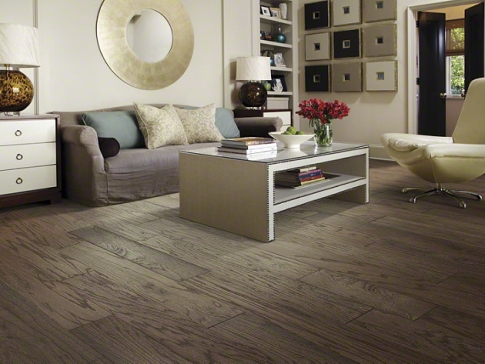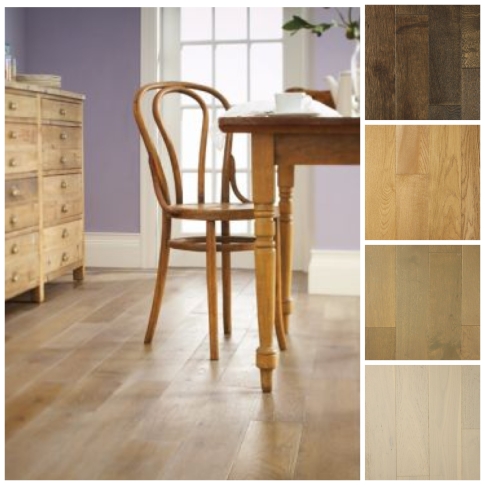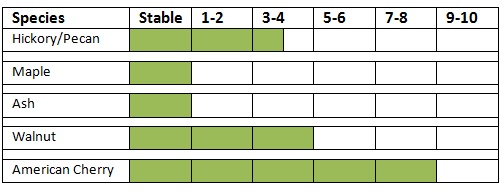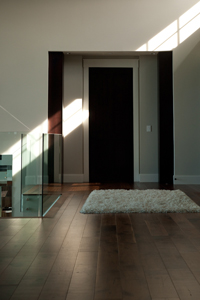Distressed floors have been a popular choice among home owners looking for a hardwood floor with distinct character. Manufacturers create the distressed look through a variety of processes including ageing, sculpting, hand-scraping and wire brushing. The intentional distress marks are great for active households with small children and pets. The scratches and dents caused by the wear and tear of everyday life will be less noticeable than with a piano finish hardwood.
Our Favourite Distressed Floors
Here’s a few of our favourite distressed hardwood floors with options for any budget.
Distressed hardwood American Restoration by Shaw Floors – $
This wide plank engineered hardwood from Shaw uses unique distressed markings to create a look reminiscent of reclaimed barnyard planks. With four colours to choose from, American Restoration is a realistic and affordable distressed choice.

Cottage Collection by Laurentian Hardwood – $$
The Cottage Collection uses a lightly wire brushed texture and low gloss finish to evoke the image of comfortable seaside cottages. This engineered hardwood comes in 10 different colours.

Castillo Plank by Antique Impressions – $$$
Inspired by the castles of medieval Europe, each handcrafted Castillo plank looks like a genuine time-worn plank walked upon centuries ago. Design options for this collection are endless with hickory or walnut planks in eight colours and a variety of plank widths to choose from.

Posted on Jul 17 2013 3:25 pm by Kelsey Myers
|
category: Hardwood Flooring |
Leave a comment
It’s not only humans that are affected by UV light – your hardwood floors are too. Avoiding the surprise of “bad tan lines” on your wood floors is a process as easy as buying sunscreen. It starts with understanding photosensitivity.
Wood is a natural material, and like fine wines, it ages. Instead of wrinkles, wood shows its age through gradual changes in colour. The amount of colour change a species of wood experiences depends on photosensitivity, also known as the reaction a material has to light.
The chart below shows the average photosensitivity of each species. Each species is rated from stable to 10, with stable species less likely to change colour and “10” species experiencing a more dramatic change in colour.

Always ask your sales representative about the photosensitivity of the specific hardwood you’re interested to get a complete understanding of the effects UV light will have on your floor.
If your dream floor is more photosensitive than you had hoped, don’t worry. Take the following steps to find out if photosensitivity will have an impact on the hardwood floor you’ve envisioned:
- Plan for the colour change by finding out what your floor will look like once its colour has changed. Will it get darker or lighter, and more importantly, do you like that colour? If you do, onto step two.
- Consider how much light the space will get. If the space doesn’t get much UV light, the colour will not change much.
- If the space does get a lot of light, consider investing in blinds or window coverings and closing them during the day to minimize UV light.
- Rearrange furniture, mats, and area rugs occasionally to ensure even colour change.
By understanding the photosensitivity of your hardwood floors you can take the appropriate steps to prevent unexpected colour changes.
Posted on Jan 26 2012 4:47 pm by Kelsey Myers
|
category: Flooring Guides Hardwood Flooring |
Leave a comment
 Hardwood floors are a great choice to consider when renovating your space. They are a timeless and elegant option that adds value to your home. Solid and engineered hardwood flooring are the two main types of hardwood. Both types are made from wood and look the same once installed – can you tell the if the photo to the left is engineered or solid? But there are some differences between them in how they are manufactured and their features.
Hardwood floors are a great choice to consider when renovating your space. They are a timeless and elegant option that adds value to your home. Solid and engineered hardwood flooring are the two main types of hardwood. Both types are made from wood and look the same once installed – can you tell the if the photo to the left is engineered or solid? But there are some differences between them in how they are manufactured and their features.
Solid Hardwood
As its name suggests, solid hardwood is milled from wood. It can be sanded and finished many times to stay in pristine condition. Solid hardwood is not recommended for rooms where moisture from daily activities or the ground could damage the floor. This includes kitchens, bathrooms, and any areas below grade such as basements. Homeowners should be prepared for solid flooring to expand and contract as moisture changes in each season.
Engineered Hardwood
Each plank of engineered hardwood is made up of multiple sheets of either hardwood, fibreboard or plywood laminated together with a final layer of hardwood on top. Each layer is put on top of each other in the opposite direction to create a dimensionally stable floor. Using this method called “cross-ply construction” creates a dimensionally stable floor that withstands changes in moisture better than solid hardwood. It is suited to kitchens, bathrooms, or basements. Engineered floors can even be sanded and refinished.
In addition to your budget and personal preference, consider the rooms you will be installing hardwood in before making your flooring decision. The research is worth it when the end result is a beautiful hardwood floor for generations to come.
Posted on Nov 30 2011 10:28 am by Kelsey Myers
|
category: Flooring Guides Hardwood Flooring |
1 Comment





